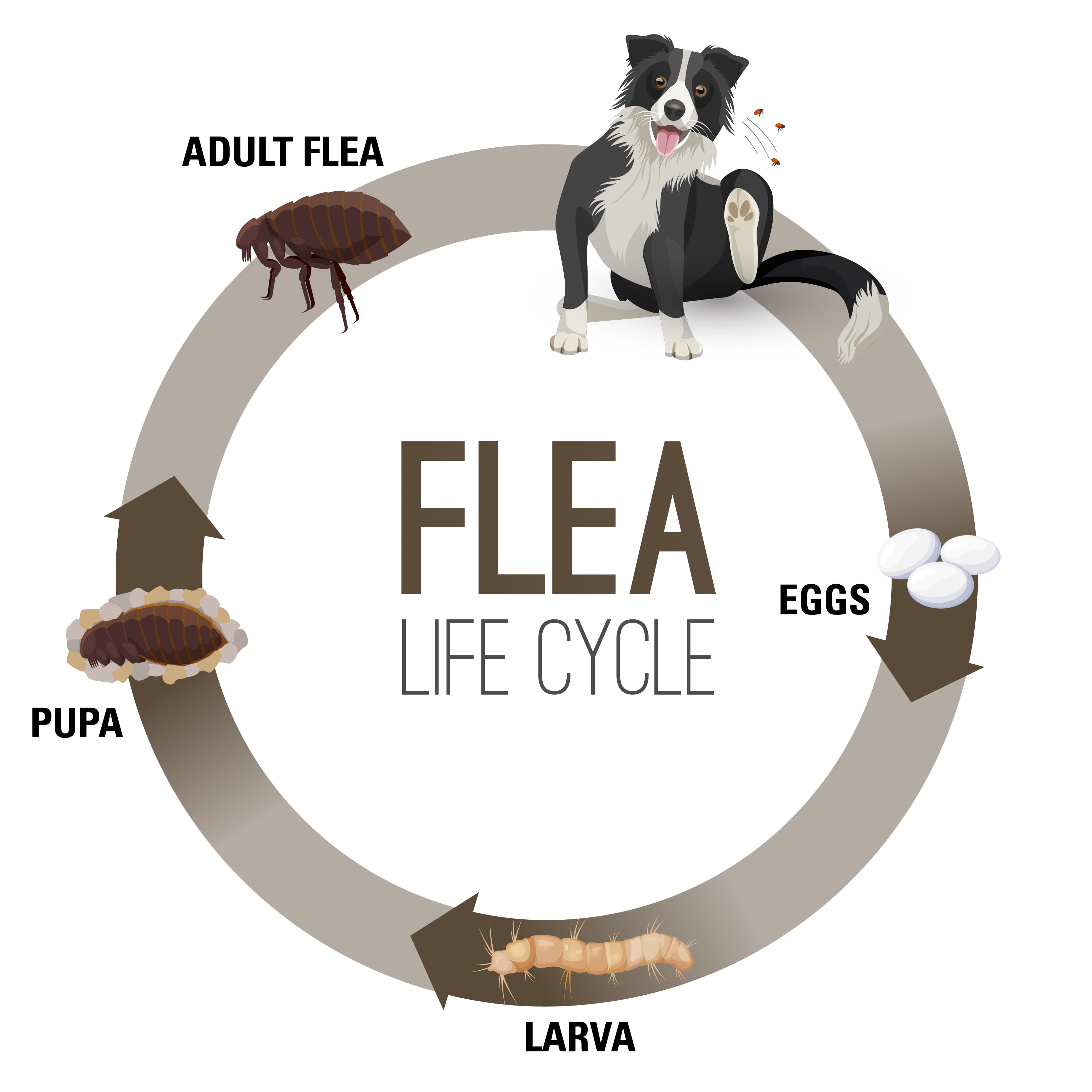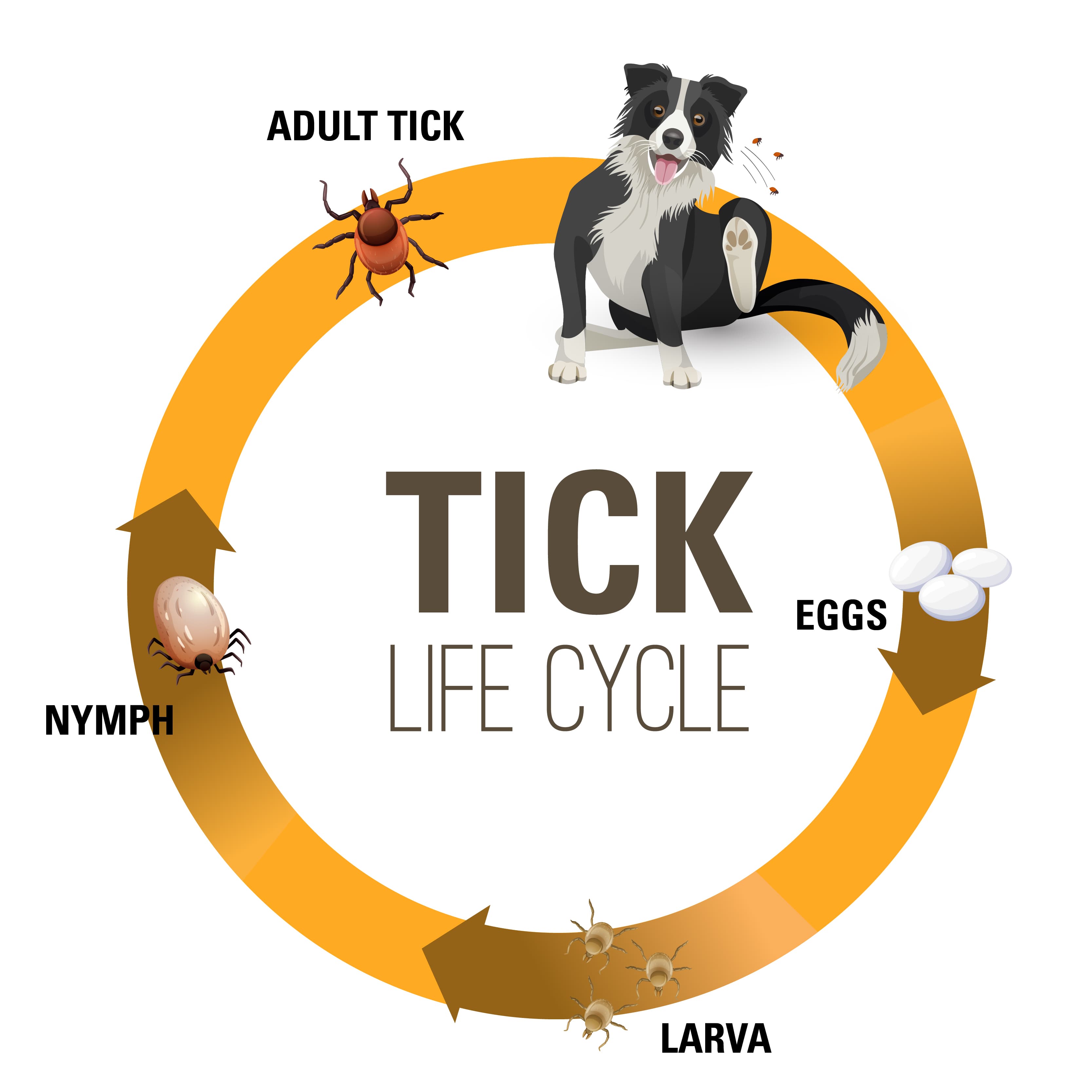The thought of fleas and ticks crawling all over your dog probably makes your own skin crawl. These tiny bloodsuckers can spread disease and give your dog (and the rest of your household) the itchy-scratchies.
They’re tenacious little parasites, but you can have a flea- and tick-free dog (and house) with year-round preventatives. Here we cover the life cycle of fleas and ticks, why they can survive winter and how they find their victims.
An Indoor-Only Dog Can Get Fleas
If you have an indoor dog that only ventures outside to go potty, that doesn’t mean they’re safe from fleas. Wildlife like opossums, rabbits, raccoons, foxes and birds can also carry fleas. If wild animals travel through your yard or sleep near your house, they can seed the environment with flea eggs. During humid months, these eggs rapidly develop into adult fleas that your indoor dog can pick up when they go potty. There’s also the chance that you have wildlife inside your house that are carrying fleas (e.g., mice).
You can also be the source of the fleas. For example, you could bring home fleas if you spend time with other people’s pets, volunteer at an animal shelter or go for a walk through a flea-infested area. Your dog could pick up fleas while they’re out and about, like at the groomers or visiting the veterinary clinic.
Fleas Love to Play Hide-and-Seek
Fleas are opportunistic, and their immature stages (eggs, larvae and pupae) can hide virtually anywhere. Even if you don’t have carpet, they can still be found in the cracks between hardwood floorboards, laminate or tile floor coverings and along baseboards. Fleas and their immature stages can hide in your dog’s bedding (and yours!) and in upholstered furniture.
Hiding helps fleas make it through winter. They can survive temperatures in the mid- to upper-30 °F range and keep nice and warm by finding cozy places to huddle up to — like the skin of your dog. Flea eggs that fell into the carpet and furniture earlier in the year can develop into adult fleas in the warmth of your house in the winter.
How Long Do Fleas Live?
Fleas typically have four life stages: adult, egg, larva and pupa. According to the Centers for Disease Control and Prevention (CDC), the life cycle of fleas can be very quick or very slow (months to years) depending on the environmental conditions. The CDC explains that flea eggs laid in the fur of the host (or their surroundings) hatch 1 to 10 days later — depending on the temperature and humidity. The larvae feed on blood and flea feces for 5 to 20 days then spin a cocoon and enter the pupa stage. It can take several days to weeks for adult fleas to appear, and they won’t emerge until they detect the presence of a host (e.g., movement, body heat). Adult female fleas start feeding within a few hours, mate soon after and lay eggs — and the cycle continues.

The Problem with Fleas
Some dogs are allergic to antigens in flea saliva and can develop flea allergy dermatitis (FAD). Unfortunately for these genetically predisposed dogs, a single bite is all it takes to develop FAD — the most common skin condition in dogs. If your dog is itching and scratching all the time, particularly along the back half of their body, they should be assessed for FAD. The good news is that if you eliminate the fleas, you eliminate the FAD.
Fleas can also carry tapeworm larvae. When your dog is grooming themselves, they can accidentally ingest an infected flea and introduce tapeworm into their body. Tapeworms don’t usually cause symptoms in dogs unless the infection is severe, but tapeworms can infect people.
Ticks Go Where the Hosts Are
Ticks are less likely than fleas to hide out in houses. They tend to be found in areas of tall grass, shrubbery, brush and other plants, where the animals they feed on will be walking by. Immature ticks can be found in leaf litter or in layers of decomposing leaves under trees and will crawl on a host when the debris is disturbed.
Ticks Can Winterize Themselves
Ticks can be very hardy and can survive surprisingly cold temperatures. They don’t usually die off in winter, even in Northern states; they just become less active. They have many options to survive a harsh winter including becoming dormant, hiding in leaf litter in woody and brushy areas, hitchhiking indoors and spending winter on an animal.
Snow can help dormant ticks by insulating them from the cold temperatures. If there are warm days during winter (temperatures above 40 °F), the adult black-legged tick (deer tick) can become active and has been found on plants above snow-covered ground waiting for a host to walk past.
How Long Do Ticks Live?
Ticks typically have four life stages: adult, egg, six-legged larva and eight-legged nymph. According to the CDC, the life cycle of ticks can take up to three years and most ticks die before completing it because they can’t find a host to feed on. Ticks can feed on a variety of host animals including mammals, birds, reptiles and amphibians, and most ticks prefer to have a different host animal at each life stage.
The CDC explains that, similar to fleas, ticks can sense animals near them by detecting their breath and body odors, body heat, moisture and vibrations. Ticks use a process called “questing” to find a host by crawling up grass blades or other plants and waiting with their first set of legs outstretched for an animal or person to walk by. When a host (like your dog) brushes by the tick, they climb aboard and look for a place to start feeding. They will feed for several hours or even days and then drop off the host into the environment.

The Problem with Ticks
Ticks can carry and transmit several different types of disease-causing bacteria, viruses and parasites (e.g., the bacteria that causes Lyme disease). The good news is that not every tick is infected with a pathogen — most tick bites don’t cause disease. But you don’t know which ticks are infected and which aren’t, which is why it’s important to use year-round tick preventives to protect your dog.
The feeding time for ticks to pass on pathogens varies among ticks and pathogens. Some bacteria may be transmitted within 3 to 6 hours of tick attachment; others require more than 24 hours before transmission occurs.
Flea and Tick Prevention for Dogs
The best way to prevent fleas and tick from inhabiting your dog (and your house) is to use year-round flea and tick preventatives. Don’t stop using them during the winter months — fleas and ticks can still be around and looking for a host to feed on. There are a variety of preventative options to choose from including topical, oral or collar flea and tick preventatives. Your veterinarian can help you decide which preventatives are the right one for your dog.
Fleas and ticks are hardy, opportunistic and patient — they don’t mind waiting for a host to come along. By using year-round preventatives, you can stop the flea and tick life cycle and keep your dog (and home) free of these tiny bloodsucking parasites.








